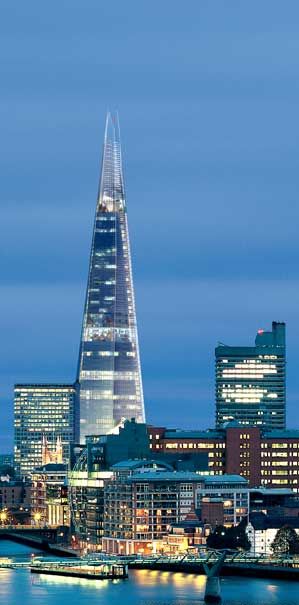The story of London, a recorded history that goes back more than 2,000 years.
Where London Got its Name
There are many theories but none of them have really been proven. Here are a few of the
more interesting ones.
An unsigned article in The Cambro Briton for 1821 suggests that the origins of the name
London come from Luna Din, which means “moon fortress'”.
In Celtic the word Londo- means “fierce”, while others have suggested a Ligurian
rather than a Celtic origin, where the root word Lond-/lont- means “mud”, or
“marsh”. One persistent theory states that the name derives from an Old European
(pre-Celtic) word Plowonida, derived from Indo-European roots Plew-, which underlies words
in different languages and means “flow”, “swim” and “boat”, where Nejd-, an
element meaning “flow”, is found in various river names around Europe. Thus the
combination of these would suggest “boat river” or “swimming river”, whereby the
Thames was too wide to ford at the location where London is today. The name of the
settlements on its banks could have been derived from this, adding the suffix -on-jon, as
would have been done during either Old European or Celtic times, to generate
(p)lowonidonjon. The Indo-European /p/ is commonly dropped in Celtic, creating
Lowonidonjon. As people tend to slur and simplify things over time, this would evolve to
either Loondonjon or Lonidonjon, Lundonjon, and then to Lundein or Lundyn. Another reason
why Lonidonjon is plausible is because it could account for the Latin Londinium, as named
by the Romans when they conquered the region centuries later.
Early History and Mythology of London
According to the legendary Historia Regum Britanniae, London was established by Brutus
of Troy after he defeated the giants Gog and Magog and named settlement Caer Troia, Troia
Nova, or New Troy, corrupted to Trinovantum. The Trinovantes were apparently the Iron Age
tribe who inhabited the area prior to the Romans. One of the area’s legendary kings was
named King Lud, who apparently renamed the town to CaerLudein, from which London was
derived. But extensive excavations have revealed no evidence of a prehistoric major
settlement in the area, although some remains of the ancient Roman city have not yet been
excavated, for which reason there may still be some hope in this theory.
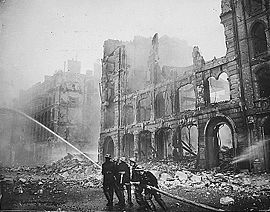
|
What has been found though are several excavations of spear
heads and weaponry from the Bronze and Iron ages, indicating that many battles took place
around the Thames, which must have served as an important tribal boundary.
One dig unearthed a series of timbers driven vertically into the ground on the south bank
of the Thames next to the SIS Building in Vauxhall, suggesting the existence of a bridge
or jetty some 3,000 years ago.London under constant
destruction and renewal, as seen here during the bombing raids of WWI and II. |
The Romans Come to London
The Romans named the settlement Londinium some seven years after their initial invasion
of 43 AD, when they landed in Kent and sailed up the River Thames. They realized it was
important to control a crossing point at the wider river, so they built their settlement
on the north bank and constructed a bridge there. The settlement was rather small, about
the size of Hyde Park, but became a capital in the second century, growing to a population
of 60,000. However, political instability and recession from the 3rd century onward led to
a slow decline until around 1500, after when the city again grew steadily in size and
prominence, reaching its Roman period size not until around 1800.
In any case, in AD 61 the native Iceni tribe, led by Queen Boudicca, rose up against the
Romans and burnt Londinium to the ground, killing all of its inhabitants.
The Romans came back though, and around 200 AD they constructed the 3km stretch of the
defensive London Wall.
In the late 3rd century, Londinium was raided several times by Saxon pirates, spurring the
Romans to construct an additional riverside wall after 255AD, which would survive another
1,600 years and define London's perimeters for centuries to come.
| But by the 5th century, with the Roman Empire rapidly
declining, their rule over Britain came to an end in 410 AD. This led to the city’s
rapid decline, becoming practically abandoned by the end of the century. But because of
its strategic location on the river, it did not remain deserted for long and started to be
inhabited by the Anglo-Saxons from the 6th century onwards, during when it must have been
an active frontier between the Saxons and Britons. Saxon
London consisted of many wooden huts with thatched rooves as shown in this picture. |
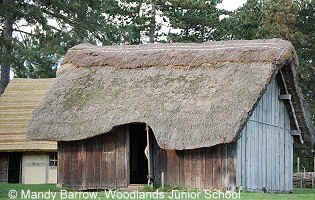
|
The Vikings Invade London
The Anglo-Saxons enjoyed two centuries of relative peace, to be disturbed by frequent
attacks by the Vikings from around 830 onwards.
In 865 the Viking "Great Heathen Army" launched a full scale invasion of East
Anglia, reaching London by 871 and camping within the ancient Roman walls during the
winter of that year. However, English forces led by King Alfred the Great would have
nothing of this and defeated the Vikings at the Battle of Edington in 878, forcing them
to sue for peace.
By the early 10th century London had become an important commercial centre. Up to that
time the Kingdom of England had been based in Winchester, but it slowly migrated to
London, moving there fully by 978.
During the reign of Aethelred the Viking raids resumed, this time led by King Sweyn
Forkbeard of Denmark. The city was again but unsuccessfully attacked in 994, numerous
raids following. By 1013 the town of London was being besieged, forcing Aethered to flee
abroad. King Sven eventually died but his son Canute continued the attacks and eventually
overran the London.
A Norse saga paints one battle during London’s Viking occupation where Aethelred
returned up the river to attack but whose army was showered by Danish spears from the
London Bridge. Refusing to give up, they pulled the rooftops off of nearby houses, holding
them above their heads and over their boats. In this way they managed to get close enough
to the bridge to attach ropes to its piers and pull it down, ending London’s occupation
by the Vikings. Some speculate that the nursery rhyme "London Bridge is falling
down" was derived from this saga.
But the Vikings did not give up either, returning against Aethelred's son, Edmund Ironside,
who managed to withstand the initial invasion. At least until he was forced to share power
with Canute. When Edmund later died Canute became the sole King of England. Two Danish
kings ruled, after which the Anglo-Saxon line was restored when Canute's stepson Edward
the Confessor climbed to the throne in 1042.
The Normans Invade London!
This time the Anglo-Saxon enjoyed
only 20 years of peace, because an invasion of Britain by the Normans in 1066 initiated
what is commonly referred to as the Medieval period.
But William , Duke of Normandy , called William the Conqueror in modern times, granted
London charter rights, paving the way for the city’s eventual self governance.
In 1176 construction began of the most famous incarnation of London Bridge , on the site
of several earlier wooden bridges, and was completed in 1209. This bridge would remain
standing for 600 years and serve as the only bridge across the River Thames until 1739.
May of 1216 was the last time London was occupied by a continental army, during the First
Barons' War when young Louis VIII of France marched through the streets to St Paul's
Cathedral and to the cheers of the entire city.
This was expected to free the English from the tyranny of King John, but turned out to be
only temporary because the barons who had initially supported the French prince eventually
changed their support back to an English king once John had died. It would then take the
city several centuries to glean out the heavy French cultural and linguistic influences
ingrained over time since the initial Norman conquest. Like Dover, London played a
prominent role in the development of Early Modern English . |
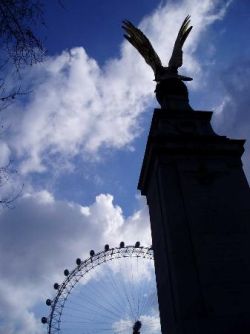
|
The Tudor Period Begins
This period ran from 1485 to 1603 and was a dramatic period of English history. Three
of the monarchs of the Tudor dynasty (Henry VII , Henry VIII and Elizabeth I) played
important roles in transforming England from a comparatively weak European power to a
formidable economy which would dominate much of the world in the coming centuries. The
Tudor period saw the end of the War of the Roses, the English Reformation, and the
Elizabethan era.
The English Reformation produced little bloodshed while most of the upper classes had
cooperated in bringing about a gradual shift to Protestantism.
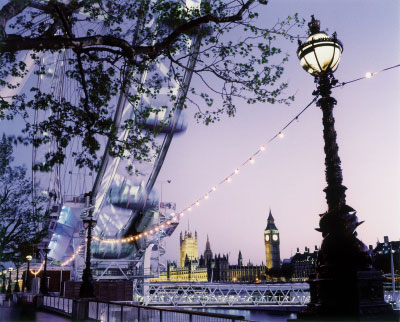
|
Great palaces such as St James were
erected by King Henry VIII, who in 1536 became famous for closing London’s monasteries
after the Roman Catholic church refused to grant him a divorce. This ended the church’s
hold on the city, much of its property transferring to private hands. The monastic one
third population of the city now mostly out of work had laid fertile ground for a major
shift to industrialization.
Now London was rapidly rising in importance among Europe’s commercial centers. Its many
small industries were booming, especially those relating to weaving. Trade had now
expanded to Russia, the Levant, and the Americas, giving birth to the period of
mercantilism and monopoly trading companies such as the Russia Company and the British
East India Company, established in London by Royal Charter. The second had eventually come
to rule much of India and was one of the key institutions in London, or in Britain as a
whole, for the next two and a half centuries. |
In 1572 the Spanish destroyed the great commercial city of Antwerp,
giving London a leading position among North Sea ports. Populations migrated to London
from all over England and Wales, but also from abroad, such as the Huguenots of France.
This influx increased the city’s population from around 50,000 in 1530 to almost 225,000
in 1605. London’s growth was also heavily fuelled by a vastly expanded use of coastal
shipping responsible for importing coal from Newcastle.
By the late 16th century, when William Shakespeare had lived and worked in London, the
metropolis was experiencing one of its most lustrous periods. Even so, there was
considerable hostility against the theatre, because such entertainment would produce
crowds, who were feared by the authorities because they might turn into mobs. Others
feared that such large gatherings might contribute to the spread of plague. The growth of
theatre was hindered by the nation’s increasingly Puritan stance, but Queen Elizabeth
loved plays and had them performed for her privately at court. She would approve of public
performances and managed to support their growth during her latter years. And it grew in
further popularity under James I, such performances complemented by elaborate masques at
the royal court. James I was the first Stuart King when he came to power in 1603,
ascending from his existing role as King James the Sixth of Scotland, as such uniting the
two countries for the first time.
London Becomes Independent
In 1625 Charles I ascended to the throne, but in January of 1642 he wished to arrest
five members of parliament, who found refuge in London. In August of that year King
Charles raised his banner at Nottingham while London took the side of parliament during
this English Civil War. The king started with an upper hand in terms of military strength,
winning the Battle of Brentford a few miles to the west of London in November. But London
quickly organized an army, forcing Charles to hesitate and retreat. This spurred London to
create an extensive system of fortifications to protect itself from any renewed attack by
the Royalists. The fortifications extended well past the city walls and surrounded
London’s entire urban area, including Westminster and Southwark. The city was never
threatened by the royalists again and its financial wealth played an important role in the
parliament’s eventual victory.
London Experiences Growing Pains
Trade and commerce grew steadily during this period, the city growing rapidly as a
result. In 1100 London's population was little more than 15,000, but by 1300 it had
ballooned to 80,000. The city’s commerce was organized into various guilds, which
effectively controlled the city and elected the Lord Mayor.
The city was built of narrow and twisting streets, and most of the structures were
constructed from combustible materials such as wood and straw, making fire a constant
threat. Sanitation was also poor, the city losing more than half its population during the
Black Death half way through the 14th century. Between 1348 and the Great Plague of 1665,
the city of London was inflicted by a total of sixteen outbreaks of the plague.
In fact, things were so bad that the city’s death rate, well into the eighteenth
century, was twice that of its birth rate. Even during the early eighteenth century the
average life span of an Englishman was only 29 years, that being considerably lower in the
city of London.
Since medieval times, the streets had always been filthy, filled with mud, excrement, and
offal. The water was polluted and rats were everywhere. The Black Death of 1348-49 killed
at least 60,000 people or two-thirds of the city with its outlying areas, subsequent
outbreaks of the bubonic plague (brought to London by rats on board trading ships)
occurring between 1603 and 1636. Even so, the city continued to grow in size, the last
major outbreak occurring in 1665, when some 70,000 had died during the summer (about one
fifth the population of the entire country). The city was also inflicted by large-scale
outbreaks of cholera up to the nineteenth century. This was primarily because people lived
in very close quarters and because hygiene standards were very low.
Samuel Pepys chronicled the epidemic in his diary. On the 4th of September , 1665 he
wrote: "I have stayed in the city till above 7400 died in one week, and of them about
6000 of the plague, and little noise heard day or night but tolling of bells."
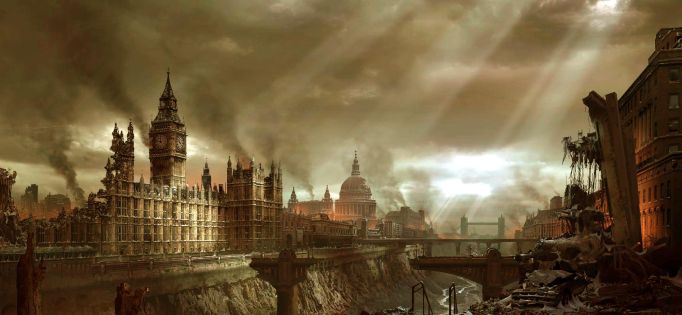
Ironically, the unsanitary conditions which helped bring on these deathly plagues were
resolved by an even greater catastrophe: the Great Fire of London in 1666, which had
destroyed two thirds of the City. 13,200 houses, 430 streets and 89 churches were ravaged
and the fire, burning enormously for four days, was visible from forty miles away.
It was spread by an easterly wind, where efforts to arrest it by pulling down houses to
create firebreaks were disorganized. The fire was quelled to some degree, but some houses
eventually blew up due to the gunpowder they had stored, giving inevitable reign to the
fire.
The fire had destroyed about two-thirds of the city and various plans were submitted how
to rebuild London, mostly suggesting large and straight roads. But none of these proposals
were implemented, the newly rebuilt city mostly following the original streetplan,
remaining as such until the present day.
London Enters a New Era
To prevent such a calamity from repeating, a shift was initiated from wooden buildings
to ones built from stone and brick. And from that point forward only doorcases,
window-frames and shop fronts were allowed to be made of wood.
By 1685 London was becoming the world's leading financial centre, now ahead of Amsterdam.
The Bank of England was established in 1694, while the British East India Company was
expanding its sphere of influence. Lloyd's of London also began operating late in the
17th century. In 1700 London handled 80% of England's imports, 69% of its exports and 86%
of its re-exports. Many of these goods were luxuries imported from the Americas and Asia
such as silk, sugar, tea and tobacco. The 86% of re-exports shows that, even though London
was inhabited by many craftsmen during the 1600s, and would later acquire some large
factories, its primary economic base was never industry. Instead, London served as a great
trading and redistribution centre. Goods were imported into the city by the country’s
increasingly dominating merchant navy, not only to satisfy domestic demand, but also for
re-export throughout Europe and beyond.
London grew rapidly during the 18th century, reflecting the
nation’s growing populace, the beginnings of the Industrial Revolution, and London's
central role in the evolving British Empire.
The coffee house became popular in London during the 18th century, where ideas were
debated, further fuelled by a growing literacy and the development of the printing press,
which would spread news more quickly and widely.
But during this century London suffered from high crime levels, leading in 1750 to the
creation of the Bow Street Runners as a professional police force. Punishments for crime
tended to be harsh, the death penalty often applied for misdemeanors. Public hangings were
common in London, and were even popular events. |
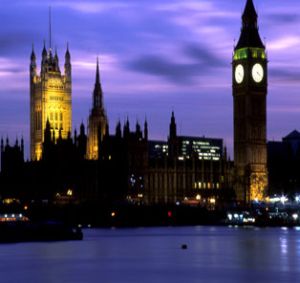
|
In 1837 Victoria became Queen at the age of 18, giving birth to what was
later referred to as the Victorian era. London was busy with trade and industry,
continuing to grow quickly. Lighting, plumbing and transport also developed and, by the
time she died in 1901, London had undergone many changes.
During her rule, the city expanded greatly as industry exploded in Britain and railways
were built to link much of Britain with its capital. London was the centre of world trade
and had a large, powerful Empire.
From the middle ages onward, and well into the 19th century, most of London was violent
and squalid. During the 18th century, the poor and the unemployed class would often forget
about their suffering by drinking themselves to oblivion, one doctor reporting that one
out of every eight Londoners would drink themselves to death. During the 1740s the
island’s population consumed 7 million gallons of gin, this dropping to 1 million
gallons in the 1780s as a result of heavy taxation.
John Ruskin would later refer to the city as "That great foul city of London, -
rattling, growling, smoking, stinking - ghastly heap of fermenting brickwork, pouring out
poison at every pore...."
In 1854, Nathaniel Hawthorne wrote a melancholy entry into one of his English notebooks:
"It has been said, ‘from Birkenhead into Hillbree - A squirrel might leap from tree
to tree’. I do not know where Hillbree is; but all round Birkenhead a squirrel would
scarcely find a single tree to climb upon. All is pavement and brick buildings now."
It was this sort of nostalgia for a rapidly disappearing rural past that inspired William
Morris to write:
Forget six counties overhung with smoke,
Forget the snorting steam and piston stroke,
Forget the spreading of the hideous town;
hink rather of the pack-horse on the down,
And dream of London, small, and white, and clean,
The clear Thames bordered by its gardens green...
While nigh the thronged wharf Geoffrey Chaucer's pen Moves over bills of lading...
Modern London
Over the 18th century the American colonies broke away and many other unfortunate
events occurred in London, while the city underwent a period of great change and
enlightenment, leading to the modern times and the 19th century.
It was during this nineteenth century that London had grown to become the world's largest
city, capital of the British Empire. Its population had grown from 1 million in 1800 to
6.7 million a century later, and during this expansionary period the city became a global
political, financial, and trading capital. Unrivaled in this position until the
century’s end, when Paris and New York grew in prominence.
The coming of the railways helped transform London during the nineteenth century, such a
new network allowing for the development of suburbs in neighboring counties. This helped
the city’s great expansion but also exacerbated a class divide, as the wealthier classes
would leave the center and the poor inhabitants within it.
To help cope with this great growth, the Metropolitan Board of Works (MBW) was established
in 1855 to provide the city with adequate infrastructure. Addressing for example London's
sanitation problems, whereby raw sewage was being pumped directly into the River Thames
and culminating in The Great Stink of 1858. The polluted Thames had also been the main
source of drinking water, resulting in constant disease and epidemics.
The MBW eventually constructed a massive network of sewers,
to become one of the largest civil engineering projects of the 19th century. More than
2,100 km of tunnels and pipes were constructed under the city, significantly dropping the
death toll in London and curtailing outbreaks of cholera and other diseases. The system is
still in use today.
London opened the world’s first underground metro in 1862, becoming electric between
1890-1905 (at first it was horse drawn).
London entered the twentieth century as the capital of the largest empire in history and
at the peak of its influence, but the new century brought with it many challenges. |
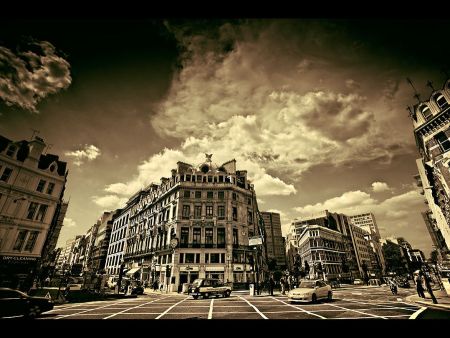
|
World War I came and London was bombed by German zeppelin airships ,
which killed some 700 people and caused great terror. But this was a mere foretaste of
what was to come.
Much heavier bombings took place during WWII, the period between September 7 of 1940 and
May 10 of 1941 seeing 71 raids on London and more than 18,000 tonnes of high explosive
dropped.
Hundreds of thousands of people were made homeless and some 690,000 children were
evacuated from the city.
After all this bombing and destruction, housing became a problem, resulting in the
erection of high-rise apartment buildings, London’s skyline changing dramatically during
the 1950s and 60s. But these proved unpopular so efforts were made to move inhabitants to
surrounding towns, increasing London’s immediate sphere of influence further.
At the close of the century Londoners were accustomed to using coal to heat their homes,
which produced large amounts of smoke. This would often lead to a characteristic smog ,
the city becoming well known for its "London Fog". This culminated in the
devastating Great Smog of 1952, which lasted five days, killed more than 4,000 people, and
led to the creation of "smokeless zones".
Around half way through the 60s London became a centre for the worldwide youth culture ,
producing such famous bands as the Beatles and the Rolling Stones. The city’s role as a
trendsetter again revived during the 80s’ period of New Wave and Punk, followed to some
extent by Britpop during the 90s.
Following the world wars greater London's population declined steadily for the next couple
of decades, dropping from a peak of 8.6 million in 1939 to around 6.8 million in the
1980s.
Most recently, it has held onto its prestigious status as a world class metropolis,
attracting Russia’s new rich, who were the billionaires said to be squeezing out the
millionaires from the city’s center. It is one of the most popular tourist destinations
in Europe and continues to thrive as a source of creativity and culture. Its next
challenge will be hosting the upcoming summer Olympics of 2012 in this overly crowded and
very expensive city.

Like this content? Please support it by pressing any or all of these links below:
Copyright © KENAX, by Karel Kosman - All Rights Reserved Worldwide.
Other Links to London Translations
We're so confident of our competitive and quality service, we'll even help you compare
against other London translation service providers!
- http://www.london-translations.co.uk/
London Translations offer the expertise of in-country translators and interpreters
combined with the simplicity and security of dealing with a company based in the UK. We
translate all business languages and specialise in translating languages from Far East
Asian and emerging East European markets.
- http://www.translate.co.uk/
As the UK's leading translation company, we have a proven track record of providing high
quality translation work in all languages to every sector of industry and commerce.
- http://www.rosettatranslation.com/
We guarantee a consistently excellent quality of translation in each of these various
fields by making sure we assign every translation to the most appropriate specialised team
of highly qualified translators, proofreaders and editors.
- http://www.templetranslations.com/
Temple Translations is the only international translation company specializing solely in
legal and financial documents. We’re in daily contact with legal systems throughout the
world and produce close to 20 million words a year from offices in London and New York.
- http://www.russianlondon.com/translation/
We are offering high-quality translation and language advisory services to institutions,
businesses and private persons who expect efficient and professional handling of their
materials. The orientation of our translators to specific spheres of activity,
availability of a wide range of professional consultants, and in-house editing of all
translated texts guarantee that the quality of our services matches your high
expectations.
- http://www.atlas-translations.co.uk/
Working for both private and public sector organisations, London-based Atlas Translations
is able to offer a complete range of high quality language, interpreting, communication
and translation services from start to finish. Atlas Translations provides a professional
and personal service dedicated to ensuring that the meaning of your message is understood
in whichever language or format you require it.
- http://www.pearllinguistics.com/
Based in the City of London, and with a network of some 4000 linguists offering 270
languages, including most rare dialects, we believe that there's no requirement that we
cannot meet. Our clientele includes Legal, Financial, Medical/Pharmaceutical companies
from both Commercial and Public Sectors.
- http://www.kwintessential.co.uk/translation/translation.html We have high
standards for our translation service. As accredited members of the Association of
Translation Companies (ATC) we demand that all our translators provide unbeatable service
in terms of their professionalism, expertise, experience and confidentiality. All our
translators are qualified pros and their work is regularly monitored by an independent
body to ensure our standards are being met.
- London pottery Home-made and hand crafted pottery for sale in London
- Travel to London from a traveler's perspective
|
